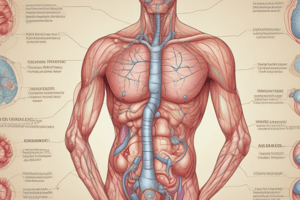Podcast
Questions and Answers
What is the approximate serum blood glucose level at which glucose typically spills into the urine?
What is the approximate serum blood glucose level at which glucose typically spills into the urine?
- 300 mg/dL (correct)
- 350 mg/dL
- 250 mg/dL
- 400 mg/dL
What is one of the common symptoms experienced by patients in diabetic ketoacidosis?
What is one of the common symptoms experienced by patients in diabetic ketoacidosis?
- Decreased thirst
- Nausea without vomiting
- Racing of the heart (correct)
- Flushed skin
What is the primary purpose of administering IV fluids in DKA management?
What is the primary purpose of administering IV fluids in DKA management?
- To lower blood pressure immediately
- To increase blood potassium levels
- To correct dehydration and acidosis (correct)
- To stabilize blood sugar levels without insulin
When should potassium replacement be considered in the treatment of DKA?
When should potassium replacement be considered in the treatment of DKA?
What is the recommended initial fluid bolus for adults with DKA?
What is the recommended initial fluid bolus for adults with DKA?
Which method of insulin administration is considered more effective for treating hyperglycemia in DKA?
Which method of insulin administration is considered more effective for treating hyperglycemia in DKA?
What situation may lead to poor absorption of subcutaneous insulin in a DKA patient?
What situation may lead to poor absorption of subcutaneous insulin in a DKA patient?
How frequently should blood sugar be monitored while a patient is on an insulin drip?
How frequently should blood sugar be monitored while a patient is on an insulin drip?
What condition can develop if dextrose is given before thiamine in malnourished or alcoholic patients?
What condition can develop if dextrose is given before thiamine in malnourished or alcoholic patients?
What is the primary issue in diabetic ketoacidosis (DKA)?
What is the primary issue in diabetic ketoacidosis (DKA)?
Which type of acidosis occurs as a result of fat breakdown due to lack of insulin?
Which type of acidosis occurs as a result of fat breakdown due to lack of insulin?
What happens to glucose levels in the kidneys when blood glucose is elevated?
What happens to glucose levels in the kidneys when blood glucose is elevated?
In what situation would a patient develop lactic acidosis?
In what situation would a patient develop lactic acidosis?
What is commonly seen in patients with diabetic ketoacidosis (DKA) besides metabolic acidosis?
What is commonly seen in patients with diabetic ketoacidosis (DKA) besides metabolic acidosis?
Which of the following is NOT a manifestation of Wernicke-Korsakoff syndrome?
Which of the following is NOT a manifestation of Wernicke-Korsakoff syndrome?
What is the ultimate consequence of the body using alternative fuel sources due to insufficient insulin?
What is the ultimate consequence of the body using alternative fuel sources due to insufficient insulin?
What is a primary cause of hypoglycemia?
What is a primary cause of hypoglycemia?
Which treatment is preferred for a conscious patient experiencing hypoglycemia?
Which treatment is preferred for a conscious patient experiencing hypoglycemia?
When IV access is not possible, what is the next step in treating hypoglycemia?
When IV access is not possible, what is the next step in treating hypoglycemia?
What is a risk associated with administering hypertonic dextrose solutions too rapidly?
What is a risk associated with administering hypertonic dextrose solutions too rapidly?
Which of the following describes a typical preparation of a preloaded syringe of 50% dextrose?
Which of the following describes a typical preparation of a preloaded syringe of 50% dextrose?
What can occur in patients who have been fasting for extended periods when given glucagon?
What can occur in patients who have been fasting for extended periods when given glucagon?
What should be avoided when administering concentrated dextrose solutions?
What should be avoided when administering concentrated dextrose solutions?
What effect does glucagon have on glycogen stores in the liver?
What effect does glucagon have on glycogen stores in the liver?
What is the primary difference between type 1 and type 2 diabetes?
What is the primary difference between type 1 and type 2 diabetes?
What role does insulin play in the body?
What role does insulin play in the body?
Which group of patients is most likely to experience hypoglycemia from oral hypoglycemic medications?
Which group of patients is most likely to experience hypoglycemia from oral hypoglycemic medications?
How does the action of rapid-acting and long-acting insulin differ?
How does the action of rapid-acting and long-acting insulin differ?
What kind of medications are primarily used to manage type 2 diabetes?
What kind of medications are primarily used to manage type 2 diabetes?
What happens to blood sugar levels after a meal?
What happens to blood sugar levels after a meal?
Which statement correctly describes insulin resistance in type 2 diabetes?
Which statement correctly describes insulin resistance in type 2 diabetes?
What distinguishes the various types of insulin available on the market?
What distinguishes the various types of insulin available on the market?
What condition is often referred to as insulin shock?
What condition is often referred to as insulin shock?
Which of the following best describes hypoglycemic unawareness?
Which of the following best describes hypoglycemic unawareness?
What can commonly treat mild hypoglycemia in patients with diabetes?
What can commonly treat mild hypoglycemia in patients with diabetes?
What percentage of hypoglycemic episodes go unrecognized in certain populations?
What percentage of hypoglycemic episodes go unrecognized in certain populations?
Which of the following is a potential consequence of iatrogenic hypoglycemia?
Which of the following is a potential consequence of iatrogenic hypoglycemia?
Which body chemicals are released to protect the brain against low blood glucose levels?
Which body chemicals are released to protect the brain against low blood glucose levels?
What symptom is commonly associated with hypoglycemia?
What symptom is commonly associated with hypoglycemia?
What is the relationship between tight blood glucose control and hypoglycemia?
What is the relationship between tight blood glucose control and hypoglycemia?
Flashcards
Diabetes
Diabetes
A disease where the pancreas doesn't function properly, leading to problems with insulin production or use.
Insulin
Insulin
A hormone made by the pancreas that helps the body use glucose for energy.
Type 1 Diabetes
Type 1 Diabetes
Type of diabetes where the body doesn't produce insulin. Patients need insulin injections.
Type 2 Diabetes
Type 2 Diabetes
Signup and view all the flashcards
Oral Hypoglycemic Medications
Oral Hypoglycemic Medications
Signup and view all the flashcards
Hypoglycemia
Hypoglycemia
Signup and view all the flashcards
Onset of Action
Onset of Action
Signup and view all the flashcards
Duration of Action
Duration of Action
Signup and view all the flashcards
Inadequate sugar intake
Inadequate sugar intake
Signup and view all the flashcards
Increased glucose use
Increased glucose use
Signup and view all the flashcards
Oral glucose
Oral glucose
Signup and view all the flashcards
Intravenous dextrose (IV dextrose)
Intravenous dextrose (IV dextrose)
Signup and view all the flashcards
Glucagon
Glucagon
Signup and view all the flashcards
Glucagon's ineffectiveness in prolonged fasting
Glucagon's ineffectiveness in prolonged fasting
Signup and view all the flashcards
Hypoglycemia: What is it?
Hypoglycemia: What is it?
Signup and view all the flashcards
Hypoglycemic Unawareness: The Silent Threat
Hypoglycemic Unawareness: The Silent Threat
Signup and view all the flashcards
Hypoglycemic Unawareness: Why is it dangerous?
Hypoglycemic Unawareness: Why is it dangerous?
Signup and view all the flashcards
Classifying Hypoglycemia Severity
Classifying Hypoglycemia Severity
Signup and view all the flashcards
The Body's Defense System: How it works
The Body's Defense System: How it works
Signup and view all the flashcards
Balancing the Benefits and Risks: Tight Blood Sugar Control
Balancing the Benefits and Risks: Tight Blood Sugar Control
Signup and view all the flashcards
Undetected Hypoglycemia: Why is it a concern?
Undetected Hypoglycemia: Why is it a concern?
Signup and view all the flashcards
Hypoglycemia Awareness: What happens over time?
Hypoglycemia Awareness: What happens over time?
Signup and view all the flashcards
Wernicke-Korsakoff Syndrome
Wernicke-Korsakoff Syndrome
Signup and view all the flashcards
Diabetic Ketoacidosis (DKA)
Diabetic Ketoacidosis (DKA)
Signup and view all the flashcards
The Key Issue in DKA
The Key Issue in DKA
Signup and view all the flashcards
Ketoacidosis
Ketoacidosis
Signup and view all the flashcards
Lactic Acidosis
Lactic Acidosis
Signup and view all the flashcards
Glucose Loss in Urine and Dehydration
Glucose Loss in Urine and Dehydration
Signup and view all the flashcards
Glucose Reabsorption in the Kidneys
Glucose Reabsorption in the Kidneys
Signup and view all the flashcards
Glucose Spillover into Urine
Glucose Spillover into Urine
Signup and view all the flashcards
Glucose Spilling into Urine
Glucose Spilling into Urine
Signup and view all the flashcards
Fruity Breath
Fruity Breath
Signup and view all the flashcards
DKA Treatment
DKA Treatment
Signup and view all the flashcards
Potassium Replacement in DKA
Potassium Replacement in DKA
Signup and view all the flashcards
Insulin's Effect on Potassium
Insulin's Effect on Potassium
Signup and view all the flashcards
IV Fluid Administration in DKA
IV Fluid Administration in DKA
Signup and view all the flashcards
Fluid Management in DKA
Fluid Management in DKA
Signup and view all the flashcards
Study Notes
Endocrine Emergencies
- Endocrine emergencies are a serious concern, particularly those involving diabetes and thyroid issues.
- Module 9 in the curriculum focuses on these emergencies.
Overview of Diabetes
- Diabetes is a condition caused by a malfunctioning pancreas.
- Insulin is needed to convert sugars into energy for the body's cells.
- Two common types are Type 1 and Type 2 diabetes.
- Type 1 diabetics do not produce insulin, rendering their cells unable to utilize sugars for energy.
- Type 2 diabetes results in the body's ineffective use of insulin, a condition called insulin resistance.
- Insulin promotes the uptake of glucose by cells and regulates blood sugar levels.
- Oral hypoglycemic medications are used to manage Type 2 diabetes, while in Type 1 diabetes insulin is essential.
Overview of Diabetes (continued)
- Most diabetic patients have Type 2 diabetes.
- Insulin use is common in both Type 1 and some Type 2 diabetes cases.
- Insulin facilitates glucose entry into cells and influences potassium movement.
Overview of Diabetes (continued)
-
Some oral hypoglycemic medications work on receptors in insulin-producing cells of the pancreas.
-
Other oral hypoglycemic agents enhance insulin's effect on cells in the body.
-
These medications can contribute to hypoglycemia, particularly for older adults and people with liver/kidney issues.
-
Different types of insulin have varying onset and duration of action.
-
Some insulins have rapid onset of action, lasting only a few hours.
-
Longer-acting insulins have a slower onset, lasting up to 24 hours.
-
Blood sugar levels fluctuate throughout the day, changing after meals or during periods of fasting or sleep.
Hypoglycemia
-
Hypoglycemia, low blood sugar, is the most common complication for people with diabetes, also called insulin shock.
-
Low blood sugars require intervention (by others, usually).
-
Hypoglycemia can stem from inadequate sugar intake or excessive insulin dosage/action.
-
Hypoglycemia incidence increases during and after physical exertion.
-
Mild cases of hypoglycemia can often be resolved by administering oral glucose.
-
In severe cases, hypoglycemic unawareness occurs, where symptoms of low blood sugar are not recognized.
-
Hypoglycemia can lead to serious neurological issues in these cases.
-
Glucose levels should be monitored regularly during treatment, aiming for a decrease of 10% per hour or a maximum of 50 mg/dL per hour.
Hypoglycemia (continued)
- Hypoglycemic episodes could go unnoticed, a condition referred to as hypoglycemic unawareness, in some cases approximately 40-50% of episodes are unrecognized.
- The body's defense mechanisms include releasing chemicals like catecholamines, glucagon, and cortisol to help raise blood sugar levels.
- These chemicals trigger symptoms such as hunger, anxiety, and sweating, which alert the individual to low blood sugar.
Management
- Hypoglycemia requires immediate treatment with oral glucose, when possible.
- Oral glucose is available as gels or tablets and could prevent choking.
- If the patient has an impaired or no airway or is unconscious, parenteral administration of dextrose is necessary.
- Common dextrose solutions include 50%, 25%, and 10% concentrations, differing in the strength of glucose they contain.
- Dextrose solutions, if not 5% or less, are given slowly to avoid vein irritation.
- Dextrose should not be injected intramuscularly or subcutaneously, as these routes are not appropriate for these high-concentration dextrose solutions.
- Treatment varies based on the patient's level of consciousness.
Management (continued)
-
If IV access is unavailable, immediately administer glucagon intramuscularly.
-
In managing hypoglycemia, glycogen stores in the liver are mobilized to rapidly raise blood glucose.
-
Vomiting is a possible side effect of glucagon administration because it can delay stomach emptying.
-
Patients in DKA are treated with IV fluids and insulin to correct dehydration and acidosis.
-
The fluid replacement must be administered slowly, without aggressive intervention unless cardiovascular instability is noted.
-
The initial normal saline fluid bolus is usually 15 to 20 mL per kg in adults.
-
IV fluids for DKA management should initially exclude potassium, since ketoacidosis generally suggests higher potassium levels.
-
Once urine output and electrolytes are stable, potassium supplementation may become essential.
-
Prehospital treatment should ideally include isotonic fluids such as normal saline or Ringer's lactate along with insulin bolus or drip if available/appropriate.
Management (continued)
- Many EMS services don't carry insulin while some may use simple IV fluids to manage high blood sugar and acidosis in the initial stages.
- The use of IV bolus insulin is sometimes less effective compared to continuous intravenous insulin infusion for severe cases of Diabetic Keotacidosis (DKA).
- In patients with weak perfusion, subcutaneous insulin absorption might be poor.
- Blood glucose needs to be monitored regularly every 30-to-60 minutes during treatment.
Rapid-Acting Insulins
- Insulin lispro (Humalog), insulin aspart (NovoLog), and insulin glulisine (Apidra) are three rapid-acting synthetic insulin types.
- These insulins have a quick onset (around 10 minutes), peaking around 90 minutes, and lasting up to 4 hours.
- Patients can receive these insulins immediately after meals or when appropriate.
Diabetic Ketoacidosis (DKA)
-
DKA is most frequent in type 1 diabetes, though it can occur with type 2 diabetes.
-
A critical factor in DKA is insufficient insulin supply.
-
Insufficient insulin prevents cells from using glucose, causing blood sugar to increase significantly.
-
Glucose-starved cells start breaking down fats, producing ketone bodies, which are acids.
-
This process, termed ketoacidosis, leads to metabolic acidosis, dehydration, and electrolyte imbalances.
-
As glucose levels exceed the kidney's reabsorptive capacity, glucose spills out in the urine, causing water loss and dehydration.
-
The breath of a DKA patient is often described as 'fruity' due to the presence of ketone bodies.
Thiamine administration
- Giving dextrose before thiamine can lead to Wernicke-Korsakoff syndrome (a neurological disorder) in malnourished or alcoholic patients.
- Thiamine should be given prior to administering dextrose to patients in such conditions.
Insulin, Regular
- Regular insulin, often labelled Humulin R or Novolin R, is hormonally classified.
- Its action involves binding to cell receptors to facilitate glucose uptake into cells.
- Adverse effects can include hypoglycemia (low blood sugar) and other symptoms depending on usage.
Studying That Suits You
Use AI to generate personalized quizzes and flashcards to suit your learning preferences.




